Honey Collection Method
The general age range to start honey hunting is around 10-12 years of age. The rainy season is from the 15th of June to the end of September. Within this time frame the main honey hunting season is is from March to June, however there can also be a second honey collection season during the month of November if the rainy season was strong. Typically a honey hunting group size ranges between 5-10 individuals, but can be made up of more people, and include both men and women. For the most part there is a job distribution between males and females. Both will go together in the forest to search for hives. Once honeycombs are found, the men do most of tree climbing and bringing down the hives, while the women on the ground squeeze the hives to collect the honey. Sometimes the women will also climb trees and bring honeycomb down, yet this is mostly with smaller trees.
There are a variety of tools for honey collection, some made directly from the forest while other materials are brought from the village. The ladder to clamber up the honeycomb laden trees are made from climbers (also known as creepers). A stabbing stick (meant to jab at the hive and make fall from the branch the honey section or whole hive itself) is also made from the forest and certain kinds of green leaves are gathered to be burned and used for smoke. The honey hunters will bring their vessels, typically plastic, from the village to collect honey in. When honey hunting, they typically do the collection process at night because during the day the honeybees are more active and could notice the humans more easily and attack. In addition, smoke is not good to use during the day. Thus, at night, the honey hunters are more safely hidden and can use smoke.
While honey collection occurs mostly in the evening, the preparation all takes place in the morning. A single tree can have as much as 50-60 hives on its branches, making it a process that takes several hours for several days. At night, the honeybees will typically have flown off to a water source and that is when the honey hunting process begins. Tree climbing for the honey hives requires using an axe to make notches in the tree or having support from the a long bamboo leaning parallel to the tree. The bundle of leaves collected will be burned and then used to directly set hives aflame. This practice has ultimately hurt the honeybee population, yet efforts such as from Gram Swaraj are working to teach honey hunters not to burn hives but use smoke only. Typically the whole comb will be harvested.
The Khadia People, most notorious for honey hunting in Orissa, will also collect honey from Rock Cliffs. Given this task is more challenging and risky, they will drink a local liquor as a way to reduce fear before going for a honey hunt. The Khadia term these cliffs as Bhandar, which means Store House. The honey gathered from these cliffs belongs to Apis dorsata, which is a species of honeybee known for being aggressive in temperament. Hence, why this species is referred to as Baghua, which is a term for tiger-like in Oriya. Wild climbers such as from Siali are used to make a ladder for rock climbing and water is sprinkled on the climber to make it flexible and strong. A honey hunter will climb down after the sun has set, while someone else above will lower down the burning leaf bundle towards the hive. The entire honey comb will be removed from the cliff and taken back to the village. When going for honey collection, the groups will bring all necessary supplies, even utensils for cooking, and return to the village 4-5 days. Once home, the honey section will be removed, filtered, and then sold to outside locals.
Indigenous People Groups
There are various tribal groups spread throughout this area of Orissa as well as other places. Some of these groups include the Kolha, Bataudi, Santal, Saunti, and Bhuiyan. There are also groups that are considered PTVG (Particularly Vulnerable Tribal Groups), specifically the: Khadia, Mankaria, and Lodha. These groups are also renowned for wild honey collection, although for the Mankaria it is not a consistent practice. Instead the Mankaria people are more known for their craftsmanship with rope making. The Khadia, Mankaria, and Lodha have a common practice of NTFP (non timber forest products) . Ten years prior, their main source of livelihood was simply NTFP collection, however now they have had to start participating in wage labor and agriculture. The other tribal groups also practice agriculture and NTFP collection but this does not include gathering wild honey. The largest community are the Santal, a tribal group that can found in multiple Indian states, while the Manakaria are the smallest group with only 103 households remaining. The Specific numbers of the tribal groups are: Santhal (51,815), Kolha (42,209), Bhuyan (16, 291), Saunti (13, 396), Bathudi (22, 604), Khadia (4000), Lodha (758), and Mankidia (580).
The communities estimate that they have lived in the area for 100-120 years, while others pose they have been there for 150 – 200 years. There is no established time as when these groups migrated to this part of Orissa and from where they came from. Other ways that these tribal groups use the forest for their livelihoods include: firewood, food and medicine from NTFP collection, agriculture implements (i.e. collecting timber to make tools such as the plough), etc. There are over 100 different types of NTFPs available, main examples being aroo root or Sal leaves for leaf plates, and much of these resources are used to to earn money.
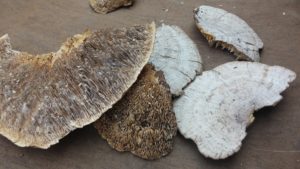

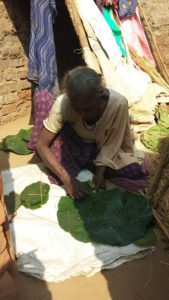
Within the communities, in general, there doesn’t seem to have been many changes within their culture and traditions. The children are now going to school and a few of the younger generation are to other locations, even other states, in search of work. Much of the latter has to do with the forest department having increased restrictions on the tribes being able to collect NTFPs, which is a major part of their livelihood and financial support. However, now that the forest rights act has come along, this should mean that the tribal groups will be to assert their right on these natural resources.
For the tribes who participate in honey hunting (mainly Khadia and Lodha, sometimes Mankaria), this wild collection is mostly done within Simlipal Biosphere Reserve but this practice also takes place in other parts of the district that surrounds this national reserve. The honey hunting season lasts for 6 months, out of which individuals from these tribes will go honey hunting for 100 days. This traditional practice is often done at evening time when it is dark, however there are times when honey is gathered from trees in the early morning.
More on the Khadia
The most prominent honey hunting group in the Simlipal area is the Khadia Tribe. The Khadia people are spread across 10 different blocks of the Simlipal Reserve, comprising 55 places with 970 households, and in total a population of over 4000 individuals in the tribes. It is believed that the terms Khadia comes from the term “Kharkhari”, which means “Palanquin” or litter. This comes from the belief that they were once the Palanquin carriers so that when royalty or officials once came to the hills then they would carry them into villages on Palanquins. Another myth for where they came from derives from the term “Savara”, which means to be primarily foragers (hunter-gatherers). By referring to themselves as “Savara” then they are depicting themselves as the first to worship Lord Jagannath, since according to Orissa legend the “Savara” were the first to worship this god.
Within the Khadia villages there are separate hamlets called Kadhia Sahi or Dehuri Sahi. A common Khadia home is made of mud and wood with a thatched roof. For water sources, these communities most often depend on flowing rivers and streams. In regards to livelihood, both the men and women play a role in domestic life, such as home construction and NTFP collection.
Forest products such as aroo root will be gathered, cut, crushed, and then drained over a sheet with water. Once dried the final product is a chalk like substance that can be take with water and some sugar, and act as an aid for stomach aches. Other forest products include Sal seed that is crushed and dried for sell , Siali leaves are stitched into a plate called Kuli and sold in the market, and broomsticks are also made. Yet, by far, the main source of livelihood for this tribal community is honey. The Khadia people honey hunt from trees and cliffs.
During the rainy season they must reduce their forest collection so they have to support livelihood through wage labor. This involves working as an agriculture labor in the fields of their own village or another neighboring village. Their staple food is rice cooked with salt, chilly, and greens. The quantity and frequency of meals is completely dependent on the seasons with with winter being the best because it has the greatest food supply both with both harvest and NTFP collection. Thus, malnutrition is very common in the Khadia tribe due to their food habit and the lack of consistency in food availability. In terms of education, it is very poor among the villages both within and outside of the Similipal Reserve. Many of the children do not go to school, especially older siblings who stay home to take care of the younger ones, and often the Khadia people are expected to marry young. Yet, this is not the case for all of the Khadia people and some villages do strive to educate their children. There are several festivals the Khadia people celebrate through the year, such as: Makar Sankranti, Raja, and Gamha. A specific festival called Magha Puja is a celebration of the new leaves of flowers before they enter in the forest for NTFP collection.
Traditional Practices
Just as honey hunting is crucial source of income for these tribal communities that rely on NTFPs for the livelihood, so too is it an integral part of their spiritual beliefs. Even before a honey hunt, a pooja (worship of god) will be observed such as the Kabali or Badam Pooja. It is believed that if the pooja is not observed prior to a honey hunt then there are strong chances of a wild animal attack when in the forest. There is no celebration after a honey hunting session. However, before being brought home some of the honey is offered to the deities in the forest.
Narratives
Surendradehuri

He is a honey hunter that comes from a village called Gandiadar, found at the edge of Simlipal National Park in Orissa. Around the age of 15-16 he began honey hunting and was taught by his father. He has been doing this traditional trade for 50 years now and there was a time when he used to go honey hunting with his wife and two sons. Yet, nowadays his wife no longer goes honey hunting and his two sons had to migrate to Gujarat in order to earn money. It is possible to collect honey for 6-7 months, along with other NTFPs (Non Timber Forest Products), however for the rest of the year there is little to no work so several of the young generation have had to migrate to make a living. Nonetheless, he continues to honey hunt because it is his livelihood and traditional duty.
During his lifetime as a honey hunter he has taught 60-70 people. There was a time when he and the other honey hunters would let children accompany them on the honey hunt so that the young ones could observe and learn. The forest department even used to watch over their children in the forest while they would collect NTFPs. In the beginning he used to collect honey by burning hives directly with fire. Yet this was killing the colonies, so now he and others of his village have switched to using smoke only and less bees are killed. This change of technic has even increased the quantity of honey and more hives can be found closer to the village as opposed to only deep in the forest. Yet, even with the increase of honey and the higher prices it affords, there is less honey collected because there a more restrictions from the forest department in allowing people to go into the forest and gather NTFPs. Thus, Surendradehuri does not know if the honey hunting tradition will continue with the next generation. The young people, like his sons, have interest to learn but they can’t afford to live there without better access to the forest.
Even against these odds he considers this practice very important and significant to his village deity. Before a honey hunt he and his team will do a pooja for the purpose of protection from wild animals. By praying to village the deity, he says there have been no animal attacks or bee stings. And in general he is proud of his community and then honey hunting that they do.
Chaitanya Katul
He has been honey hunting for 35 years and began this ancestral trade when he was 20. He was taught by his father, mother, and brother. He himself has taught 6 other people these traditional skills, out of which 3 have become master trainers of honey hunting in the village. When he goes for a honey hunting expedition, he will go to the forest with a large group of people. There they will sit and discuss the strategies, then the group will divided into smaller groups that often comprise of family and sometimes other village individuals. For him, this practice is a means of livelihood and even a good business because it does not a person having to invest money, one simply needs access and trained skill in the forest.
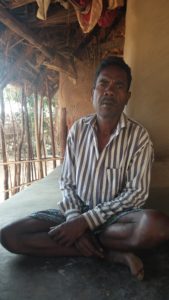
There have been a few changes to the collection strategy since he became a honey hunter. For instance, he used to cut down the entire honey comb and squeeze out the contents, which often included larva and other pieces of the comb. An entity intervened on the behalf of the bee survival and taught the honey hunters, such as Chaitanya, how to cut only the honey section out comb and squeeze only honey portion. This not only ensures that the honey collected is more hygienic but is also more sustainable for the honeybees. Honey was once collected into pots and oil cans, and within the latter the honey would be made to smell bad; and the honey is collected with plastic containers.
He has also had his fair share of risky encounters in the forest when going for a honey hunt. For instance, one morning he went to the forest with his uncle and few other honey hunters. On the way they encountered an elephant, which started chasing them and everyone scattered in fear. Chaitanya then found himself alone in the forest, without his shoes or food he brought for the expedition. Once he finally found his friends, the elephant had gone to the river for a bath. So they were able to return to their honey hunting work and bring honey home safely to their families. His wife took some of the honey and cooked it with rice for the children and the rest was sold at the market. A positive outcome to such risky business.
Phaguni katual

After getting married she began honey hunting; she is now 45 but doesn’t know they age she married and started this forest vocation. Both her father and brother taught her the necessary skills, and she herself has taught 4-5 this traditional practice. She continues honey hunting for the purpose of earning money for her family. Honey hunting is also her habit. Often her son will accompany her during the honey season. She will even climb the trees to collect to face the buzzing hives and collect the honey.
Like almost every other honey hunter in the village, she has encountered wild animals in the forest. One day she had gone to the forest for honey collection and saw an elephant from far away, to which she became afraid and ran away. While running she ripped her clothing and ultimately returned to the village without honey. Sometimes, these excursions are botched by factors that cannot be controlled.
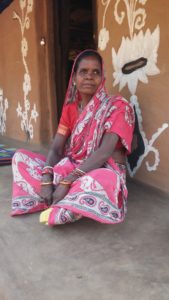
Kasturi Palei
She says the forest is her life and without the forest she cannot live. That is one reason she continues honey hunting and has been doing so for the last 25 years. It is a way not only to support her family but to also earn money. She fulfills several roles as a honey hunter, from climbing the tree and cutting down the comb to helping give tools to her husband while on the ground. Over the years that she has honey hunted there have been some changes, such as mud pots to collect the honey being replaced by plastic containers.
Even the quantity of honey has changed, having increased over the years; yet even with this fortunate growth, the honey collection has reduced. This is due to the forest department incurring more restrictions on the honey hunter communities. Even still she believes this ancient practice will continue with the younger generation, not only her son but also grandson.
Parvati Diegar
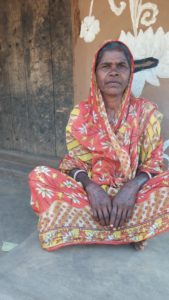
Parvati is a member of the village called Junpaleodadiha, which is also at the edge of the Simlipal National Reserve and part of the Khadia tribe. She is not sure how old she is but estimates to be in her 60s and possibly has honey hunter for 30-40 years. Parvati was taught by her husband how to honey hunt and later taught her son the skills of this ancient practice; he is only individual she has taught. For her, honey hunting is a means to earn money for her and her family, especially with supporting health costs. Often the group she goes to honey hunt with are her family and a few other villagers. In the group she does not climb the trees but will help her husband with tasks on the ground below.
Like others before and in her village, she has experienced dangers when going to collect this NTFP from the forest. After completing a honey hunting session one season, she and the other honey hunters took rest for the night in the forest. All the honey hunters were sound asleep when a tiger suddenly came and attacked her husband. The husband cried out and the others instantly woke; they quickly attacked the tiger with burning sticks and axe until the tiger went away. Fortunately the husband came out of the situation unharmed and the group even stayed sleeping there in the forest that night. However, this sort of good fortune with wild animals is not always the case and there are plenty of instances when honey hunters have come out scathed, even fatally, after such instances. Parvati also recalled a story of two men from her village who had been attacked and killed, which even caused honey hunting to decrease. Even against the risks she has faith that the children of the village with continue honey hunting. In fact, she related a memory of a group of children who were told to practice their school work and instead laid their slate at the bottom of a tree then climbed the tree for money. At least, the interest in these ancestral practices is still steadfast.




